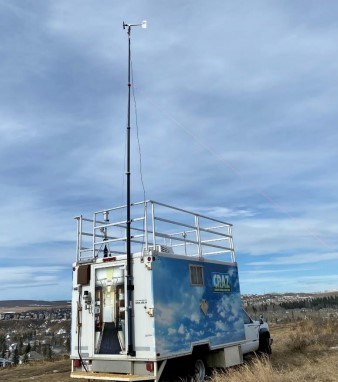At a talk sponsored by the Cochrane Environmental Action Committee (CEAC) at the Frank Wills hall Saturday, attendees were brought up to speed on how the impacts of wildfire smoke are monitored and whether or not Cochranites’ health may be at risk.
There was no shortage of technical detail presented by the non-profit air quality monitoring group Calgary Region Airshed Zone (CRAZ) spokesperson. The CRAZ monitors air quality in Calgary and region.
The bottom line, and the answer to the question, “Is our health at risk in Cochrane due to wildfire smoke drifting here?” is: no, we are well withing safety guidelines. The clear message was the risks are minimal 99 per cent of the time, but wildfire smoke will affect those most vulnerable, such as children and the elderly and those with respiratory or heart disease.
CEAC is a member of CRAZ. They invited CRAZ to town as part of their ongoing Sustainability Series.to answer questions and provide some insight into how air quality is monitored.
CRAZ looking to partner with municipalities in monitoring.
Speaker Mandeep Dhaliwal, the air quality program manager at CRAZ, said they sent their mobile monitoring station to Cochrane twice.
“It was deployed twice at Mitford Park – in from October 2018 to March 2019, and again in April 2020 to September 2020,” he said.
Results both times indicated to cause for concern for PM 2.5, NO2, or O3. The mobile data showed that our air quality was good, with some SO2 from time to time but nothing to be concerned about.
PM 2.5 is particulate matter under 2.5 microns in diameter, or less than the diameter of a human hair. Particles in this range can penetrate deeply into the lungs and even the bloodstream, causing significant damage.
Also known as Fine Particulate Matter, PM 2.5 typically consists of a mix of things like smoke, soot, liquid or solid particles in aerosol, or biological matter like mould, bacteria, pollen and animal dander.
Dhaliwal said fires are affecting us more and more, and there is a side effect that allergy sufferers might not be aware of. Pollen from plants could be carried to Cochrane from as far away as Kelowna.
“Fire smoke can trap pollen and help transport it, bringing (types of) pollen to an area where it previously didn’t exist,” he said.
This can potentially lead to higher-than-usual pollen levels in areas where the local plant life would not normally produce that much pollen.
This might be part of an explanation as to why some people experience more allergies as they get older.
The CRAZ has three continuous monitoring stations operating in Calgary and one in Airdrie.
To illustrate just how air pollution ignores political boundaries, Dhaliwal told the story of a Red Deer exhaust system manufacturer that was charged by the U.S.’s Environmental Protection Agency in 2022.
The company was investigated and had to stop selling devices that bypass or disable vehicle emissions control systems. The EPA fined them $1.6 million for causing emissions in the U.S.
Alberta is only province that has non-profit air quality monitoring. The Albert Airsheds Council compares all the monitoring sites.
The public is encouraged to join CRAZ as members.
CRAZ’s Community Guide to Wildfire Smoke and Health can be found at https://craz.ca/community-guide-to-wildfire-smoke-and-health/. There is real time data on the CRAZ monitoring page.




